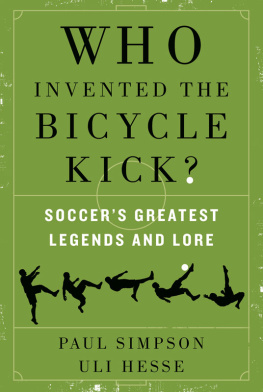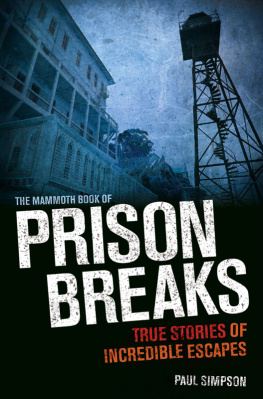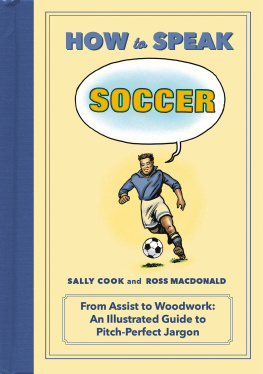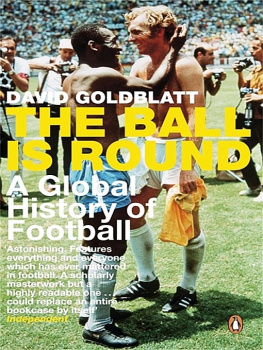If you believe Uruguayan writer Eduardo Galeanos Football In Sun and Shadow , this question has a straightforward answer. To quote Galeano: Ramn Unzaga invented the move on the field of the Chilean port Talcahuano: body in the air, back to the ground, he shot the ball backwards with a sudden snap of his legs, like the blades of scissors.
Galeano does not date this historic moment but popular tradition has it that Unzaga invented this move in 1914 in Talcahuano. A naturalised Chilean he had emigrated from Bilbao with his parents in 1906 Unzaga loved launching bicycle kicks both in attack and defence. After he showed off his trademark move in two Copa Americas (1916 and 1920), the Argentinian press dubbed the bicycle kick la chilea .
As comprehensive as that narrative might sound it finds no favour in Callao (Perus largest port), nor with Argentine journalist Jorge Barraza, whose investigations suggest the move was invented by a chalaco (as Callao locals are known) of African descent who tried out the acrobatic manoeuvre in a game with British sailors. Peruvian historian Jorge Bazadre suggests this could have happened as early as 1892. The Chileans could, Barraza speculated, have copied the bicycle kick from regular matches between teams from Callao and the Chilean port of Valparaso. If you believe this theory, the bicycle kick is truly la chalaca (Chalacan strike).
In his 1963 novel The Time Of The Hero , Mario Vargas Llosa suggests that people in Callao must have invented the bicycle kick because they use their feet as efficiently as their hands. However, neither Chile nor Peru will ever relinquish their claim to have invented this spectacular move. Which, when you think about it, is strange, because a bicycle kick presupposes that somebody else has not done their job properly. German scientist Hermann Schwameder, an expert on motion technique, says what you need is instinct, a lot of courage and a bad cross. Klaus Fischer, who scored with the most famous bicycle kick in World Cup history (it tied the 1982 semi-final between France and West Germany at 3-3 in extra time) agrees: By and large, you have to say that every cross that leads to a bicycle kick goal is not a good cross.
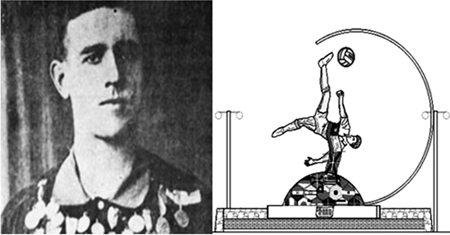
The much-decorated Chilean Ramn Unzaga, putative inventor of the bicycle kick. The equipment, right, is not recommended for home use.
Yet, on one famous occasion, a not very good penalty led to a bicycle kick goal. In May 2010, in the Hungarian top flight, Honved were 1-0 up against their great rivals Ferencvaros, when they won a penalty. Italian striker Angelo Vaccaro stepped up to seal the victory. He struck the ball at a perfect height for the keeper who punched it into the air. Vaccaro waited for the ball to come down and, with half an eye on the on-rushing defenders, flicked it over his head (and the keeper) and into the net.
Even if you dont miss a penalty first, a good bicycle kick is a shortcut to glory though sometimes that glory is short-lived. Zlatan Ibrahimovis overhead wonder goal against England in November 2012 was feted as one of the greatest ever. That same month, trying to replicate his effort in a French Cup tie for PSG against Saint-tienne, he missed the ball completely.
Wayne Rooneys spectacular overhead kick in the Manchester derby in February 2011 was voted the best goal in the history of the Premier League. The player didnt romanticise his achievement, saying: I saw it come into the box and thought, why not? Therein, perhaps, lies the secret of the moves enduring appeal: it is rare in life that we see human error (a bad cross) so swiftly redeemed by human genius.
Even a missed bicycle kick can have unforeseen consequences. At USA 94, with the hosts minutes away from a 2-1 victory against Colombia, Marcelo Balboa startled the Rose Bowl crowd with an inspired bicycle kick that flashed just over the left-hand corner. If it had gone in, it would have become one of footballs most famous YouTube clips. It didnt but it still inspired Denver billionaire Philip Anschutz who vowed: Thats the guy I want to play for my team. Balboa was signed by Anschutzs Colorado Rapids and the billionaire became such an enthusiast he invested in the Chicago Fire, New York/New Jersey Metro Stars, the LA Galaxy, DC United and the San Jos Earthquakes six out of ten Major League Soccer franchises. So you could say Balboas bicycle kick launched the MLS.
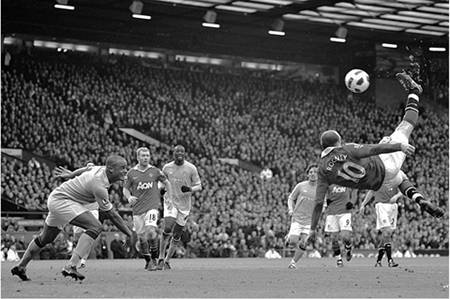
Rooney pulls it off. His great bicycle kick against City was improvised from a mis-hit cross from Nani. The move is said to have been introduced to England in the 1960s by Uniteds Denis Law, who had picked it up at Torino.
( Getty Images )
There are other, less convincing, claimants for the honour of inventing the bicycle kick. Legendary Brazilian striker Lenidas, whose elasticity earned him the nickname Rubber Man, claimed the move was his creation. But he first used it, records suggest, for his club Bonsucesso in 1932 more than a decade after Unzaga. Chronology counts even more decisively against Carlo Parola, the Juventus centre-back who used the trick so often he was known in Italy as Signor Rovesciata (Mr Reverse Kick) and Doug Ellis, the deadly Aston Villa chairman who claimed to have invented this move while playing for Southport during World War II.
By then, though, the bicycle kick had achieved international notoriety. In 1927, Chilean club Colo Colo toured Europe and their 24-year-old striker, captain and founder David Arellano performed the trick so often he was the toast of Spain until he was killed, struck down by peritonitis after colliding with another player during a match in Valladolid. The black line above Colo Colos club emblem is a memorial to a flamboyant striker whose memorably premature death is a grim warning about the perils of showboating.

Regal Records in 1932 : the first FA Cup final souvenir disc was a 78rpm record commemorating the clash between Arsenal and Newcastle. This first entry in a genre we might call FA Cup vinyl was very different to its successors. For a start, the record was released before the final. And instead of the catchy, platitudinous pop songs that became obligatory, this record consisted of interviews with the players. Each finalist had a side of the record to themselves.
Controversial it isnt. The announcer, who sounds as if hes killing time before narrating his next Path newsreel, introduces the Gunners popular captain Tom Parker the right full-back, a wholehearted player, who is respected by his colleagues and opponents throughout the football world, and is equally as a good a fellow. Parker then describes the recording as a greater ordeal than anything that Wembley has to offer before promising that his team will play the game and play it well. (In the event, they lost 2-1, with Newcastle equalising controversially from a move during which the ball had gone out of play.)
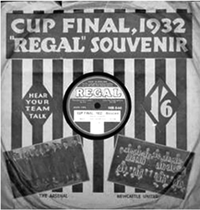
There was then a strange lull before the vinyl baton was picked up in France, Germany and the Netherlands. Before the Bundesliga was founded in 1963, the national championship was decided by a cup final. In 1959, a composer called Horst Heinz Henning decided to celebrate the fact that local rivals Eintracht Frankfurt and Kickers Offenbach had reached the final by releasing a record which had an Eintracht song on one side and a Kickers tune on the other. A one-man hit factory with more pen names than Jonathan King, Henning never showed a trace of humour in his songs but, in 1977, surprised everyone by releasing a record called The House At The Arse End Of Nowhere.

